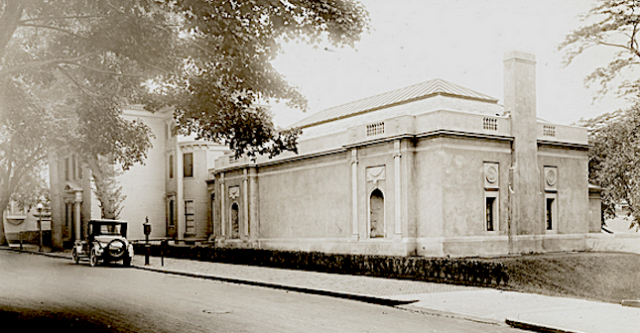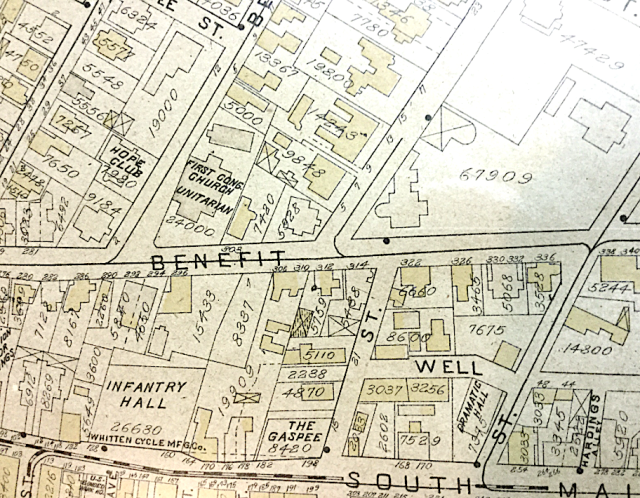
Correspondents have weighed in on the Shepley Library, and perhaps the most interesting suggestion comes from Peter Van Erp, who contends that the Shepley Library was not on what are now the grounds of the John Brown House. In fact, the passage from Providence’s Benefit Street that I interpreted as saying so does not necessarily say so.
Attributed by authors Ellysa Tardif and Peggy Chang to historian Margaret Stillwell, the passage reads: “… just beyond the John Brown House stood a ‘little building put up by Colonel George Shepley to house his collection of Rhode Island books, prints, and manuscripts’” Arguably, “just beyond the John Brown House” could mean a distance beyond the Brown House compound. The address 292 Benefit is indeed a block north and on the opposite side of Benefit from the compound.
In fact, 292 Benefit still exists, though it is not listed in the 1985 architectural survey by the Rhode Island Historical Preservation & Heritage Commission. And as Peter points out, the land on which the library would have sat is in fact a parking lot – across the street from my first tiny apartment (1984-90) in Providence, directly north of the Hope Club parking lot (occupied until 1960 by 2 Benevolent St. on the map at the bottom of this post). Below is the Shepley House at 292 in a photograph from a real-estate website. Notice that it has the same ornate entrance portico as the one to the far left of the photo, above, of the Shepley Library and Shepley House.

It is definitely the same house. Below is a detail from my 1895 plat map expanded to the area just north of yesterday’s map. So now we have moved closer to solving our mystery of the Shepley Library. Much remains to be learned, but we now know where it is, or was. Many thanks, Peter, for your excellent architectural detective work!




Library of Congress has 1920-21 Sanford Fire Insurance Maps. They clearly show the “private library” next to the Shepley House.
https://www.loc.gov/resource/g3774pm.g3774pm_g08099192102/?sp=8&r=0.466,0.388,0.606,0.23,0
LikeLike
H.P. Lovecraft gave a vivid account of visiting here in a letter of November 1923. It can be found reprinted in full in “Letter to Maurice W. Moe” (pages 133-35).
LikeLike
I’ve heard that Lovecraft wanted to write a book about Providence, and especially about its architecture, and that he was compiling material for it, but I’ve never read any of that material. Maybe the letter to Maurice Moe is part of that material. You refer to pages 133-135, but from what book? I think there may be several books of HPL’s letters. Perhaps the shop at the Arcade has one or more – if that shop even exists anymore. Anyway, thank you for the heads-up!
LikeLike
The book is “Letters to Maurice W. Moe”, published by Hippocampus. My typing left an “s” off the book’s title, which may have confused matters. Amazon often have “slightly imperfect copy” offers on the Lovecraft letters (published in good form by Hippocampus), which have enough vivid material in them to make a chunky six-volume book series on Providence architecture, parks and museums/galleries, without even needing to dip into the fiction. You may not want to get them at a regular store, as they would have to be specially ordered and you’d have to pay full price+. I have a page here that offers a succinct beginner’s guide to getting started re: the great range of Lovecraft books. https://tentaclii.wordpress.com/lovecraft-start-here/ At the same site you’ll also find much to interest re: old Providence and its buildings and views.
LikeLike
Many thanks, David, for your detailed reply. I am surprised given the amount of material evidently available that no book collecting his writing on his own city has been published, at least not so far as I know. But I will check out some of the letters and collections that you suggest, and if I am successful maybe will quote in my blog at length (for me at least) from HPL’s letters to friends on Providence.
LikeLike
It would certainly be a great retirement project for someone, to go through all the letters in a couple of months (four or five more volumes are currently appearing annually, with the two volumes of letters to his Providence aunts eagerly awaited later this summer, and likely to be ‘rich pickings’). Marking and indexing all of the most interesting and vivid passages re: Providence architecture, by-ways and parks, museums etc. Note here that David E. Schultz, who co-edits the volumes of letters, has every letter and postcard transcribed in a set of Word documents. As such, the assemblage of such a book series would not be too arduous for an organised assembler, though it might best be divided into themed books (e.g. fine and old houses of Providence and its environs; the commercial district inc. cafes and bookshops, railway station, theatres and civic buildings; the waterfront slums, warehouses, Federal Hill and other suburbs; Brown and College Hill, Blackstone Park and the Seekonk; the museums and galleries; and also prospects, byways, nooks, lanes and courtyards and their cats). I note that George Laswell’s artbook “Corners and characters of Rhode Island” (1924) is now in the public domain, with many fine pen drawings of Providence buildings. As an initial ‘starter’ project with visual appeal, one might pair the buildings drawn by Laswell with facing passages from Lovecraft’s letters, fiction and poetry.
LikeLike
David, Take a look at the 1918 Plat Book page linked here, and you’ll see George Shepley’s property identified by name, roughly at 296 Benefit Street. While the properties at 292 and 294 Benefit Street have different names attached; even though they seem to show the Library Building area. Please let me know what you make of these details. But I think you are going to really enjoy the Plat book pages available to you at this site!

Will Hart
LikeLike
Thanks for sending this, Will. I think Nos. 292, 294 and the receding 306 (“Lederer”) properties are all gone today, but the first two might have been around after the Shepley Library went up, presumably just to the south of the Shepley house (now known as the Mason House, which may still exist, as does the outbuilding to its rear, now renovated into a residence. I think the Lederer property must have been taken down, perhaps first purchased by Shepley, to make way for the Shepley Library after 1918. To judge by the photo at the top of this post, the Shepley Library was built just north of 308 (now numbered 292, I believe, unless I was wrong in the post above), with a lawn separating it from the Shepley house. I figure the Shepley occupied the Mason House sometime in the early 1900s and built his library in the very late ‘teens or early ’20s.
All this may be quite wrong, and my mind swims at comparing the three maps involved, including yours, with the realization that not only are certain buildings gone but address numbers may have changed. This architectural sleuthing is fantastic. Are you involved in this August’s Lovecraft event?
LikeLike
Pingback: Shepley Library on Benefit? | Architecture Here and There
David
Please call me!
Have to speak about Welcome Arnold.
Bob Burke. 441-2345
LikeLike